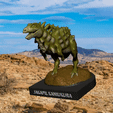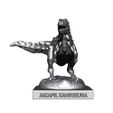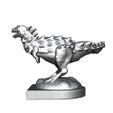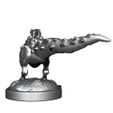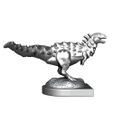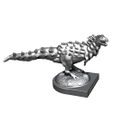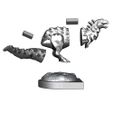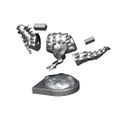JAKAPIL KANIUKURA.
**Because the Jakapil holotype is a subadult, its full size is not yet known, with the holotype measuring around 1.5 meters in length and weighing between 4.5 and 7 kilograms, depending on femoral circumference. Jakapil had a short, stocky skull, lacked an antero-orbital fenestra, and had only 11 pairs of teeth in the lower jaw, a small number for non-ankylosaurid thyreophorans, its teeth were leaf-shaped and lacked a girdle. Due to the shape of its snout, it is believed that Jakapil did not cut leaves but fed on harder vegetation. Jakapil represents a novel morphotype among thyreophorans, including, among other things, the presence of a predentary bone, absent or cartilaginous in other basal thyreophorans, 2 large, low osteoderms, and a bipedal posture, similar to Scutellosaurus.
Their hindlimbs were similar to those of other basal thyreophorans and ornithischians, with long tibiae and fibulae. Its pelvis was also basal, unlike in ankylosaurids its pubis and ischium were separate. His body was covered in osteoderms, with at least five types. The sides of the neck, large, with little elevation and D-shaped, those above the neck, long and pointed, similar to a thorn, those below the neck, an intermediate point between the previous two, raised and thick but not pointed. Those on the back, similar to the previous ones but smaller and on the body, oval, typical in ankylosaurs. Their arms were short, despite appearing useless due to their small size, they have muscle insertion areas, similar to those of Huayangosaurus, which suggests that they still had utility, although not for locomotion.
*Discovery and research
**Jakapil was a basal thyreophoran from the Late Cretaceous of Argentine Patagonia, found in the La Buitrera Paleontological Area.
**Holotypic specimen MPCA-PV-630 consists of a partial skeleton including various osteoderms and a complete mandible. The remains were found near the town of Cerro Police within the "La Buitrera Paleontological Area", near the E. Ramos Mexía Dam, in Northern Patagonia, Río Negro Province, Argentina. The outcrops exposed there represent the upper section of the Candeleros Formation dated to the Cenomanian. They are interpreted as eolian accumulations of the Kokorkom desert, with changes between arid and semi-arid climatic conditions. Most of the fossils from La Butrera were found between migratory dune beds. The new specimen was found as a close association of elements in a small area of ??about 1.5 by 1 meter, isolated from any other individual, as is usually the case in the Candeleros Formation. The remains were found disjointed and with a slight southwest-northeast orientation due to dune transport.
**Jakapil means "bearer of shields" in the northern Puche or Tehuelche language. The specific name kaniukura is composed of kaniu, crest, and kura, stone, which comes from the Mapuche language, referring to the crest of the jaw.
*Classification
**Due to a combination of features seen in basal ornithischians, basal thyreophorans, and ankylosaurs, a phylogenetic analysis placed it as a basal thyreophoran, outside the clade Eurypoda. Riguetti et al. from 2022 suggest that Jakapil represents a member of a previously unknown clade of thyreophorans.
*Phylogeny
**Its Phylogenetic position depends on which perspective is taken when classifying Thyreophora. Following the data matrix of Soto-Acuña and colleagues, we recover Jakapil as the sister taxon of Ankylosauria.
https://en.wikipedia.org/wiki/Jakapil
*The figure is divided into 3 parts, joined by 2 connectors and a base of approximately 7 cm in diameter. The complete figure is approximately 9cm high and 15cm long approximately *.
*If you are going to download it: know that it is a great support for me. Hope you enjoy the model. Feel free to report any errors you find in the files to try to fix them.
If it is not annoying, please share with me a photo of your make on my facebook or instagram (https://www.facebook.com/altresdeaficionado - https://www.instagram.com/al.tres.de/)
At your service. Juan Carlos.*
JAKAPIL KANIUKURA JAKAPIL KANIUKURA **JAKAPIL KANIUKURA
**Because the holotype of Jakapil is a subadult, its full size is not yet known, the holotype is about 1.5 meters long and weighs between 4.5 and 7 kilograms, depending on femoral circumference. Jakapil had a short, stocky skull, lacked an anteroorbital fenestra and had only 11 pairs of teeth in the lower jaw, a small number for non-ankylosaurid thyreophorans, its teeth were leaf-shaped and lacked a waist. From the shape of its snout, it is believed that Jakapil did not cut leaves but fed on harder vegetation. Jakapil represents a novel morphotype among thyreophorans, including, among other things, the presence of a predentary bone, absent or cartilaginous in other basal thyreophorans, 2 large, low osteoderms, and a bipedal posture, similar to Scutellosaurus.
Its hind legs were similar to those of other basal and ornithischian thyreophorans, with long tibiae and fibulae. Its pelvis was also basal, unlike ankylosaurids, its pubis and ischium were separate. Its body was covered with osteoderms, with at least five types. The sides of the neck, large, with little elevation and D-shaped, those above the neck, long and pointed, similar to a spine, those below the neck, an intermediate point between the two previous ones, raised and thick but not pointed. Those on the back, similar to the previous ones but smaller in size, and those on the body, oval, typical of ankylosaurs. Their arms were short, despite appearing useless because of their small size, have areas of muscular insertion, similar to those of Huayangosaurus, suggesting that they still had utility, although not for locomotion.**
*Discovery and research.
**Jakapil was a basal thyreophoran from the Upper Cretaceous of Argentine Patagonia, found in the La Buitrera Paleontological Area.
The holotypic specimen MPCA-PV-630 consists of a partial skeleton including several osteoderms and a complete mandible. The remains were found near the locality of Cerro Policía within the "La Buitrera Paleontological Area", near the E. Ramos Mexía Dam, in Northern Patagonia, Río Negro Province, Argentina. The outcrops exposed there represent the upper section of the Candeleros Formation dated to the Cenomanian. They are interpreted as eolian accumulations of the Kokorkom Desert, with changes between arid and semi-arid climatic conditions. Most of the La Butrera fossils were found among migratory dune beds. The new specimen was found as a close association of elements in a small area of about 1.5 by 1 meter, isolated from any other individual, as is usually the case in the Candeleros Formation. The remains were found disarticulated and with a slight southwest-northeast orientation due to dune transportation.
**Jakapil means "shield bearer" in Puché or northern Tehuelche language. The specific name kaniukura is composed of kaniu, crest, and kura, stone, which comes from the Mapuche language, referring to the crest of the jaw.
*Classification
Because of a combination of features observed in basal ornithischians, basal thyreophorans, and ankylosaurs, a phylogenetic analysis placed it as a basal thyreophoran, outside the clade Eurypoda. Riguetti et al. of 2022 suggest that Jakapil represents a member of a previously unknown thyreophoran clade..
*Phylogeny
Their phylogenetic position depends on the perspective taken in classifying Thyreophora. Following the data matrix of Soto-Acuña and colleagues, we recover Jakapil as the sister taxon to Ankylosauria.
https://en.wikipedia.org/wiki/Jakapil
*The figure is divided into 3 parts, joined by 2 connectors and a base approximately 7cm in diameter. The complete figure is approximately 9cm high and approximately 15cm long *.
*If you download it: know that it is a great support for me. I hope you enjoy the model. Feel free to report any errors you find in the files so I can try to correct them.
If it's not annoying, share with me a photo of your make on my facebook or instagram (https://www.facebook.com/altresdeaficionado - https://www.instagram.com/al.tres.de/ )
At your service. Juan Carlos.*

